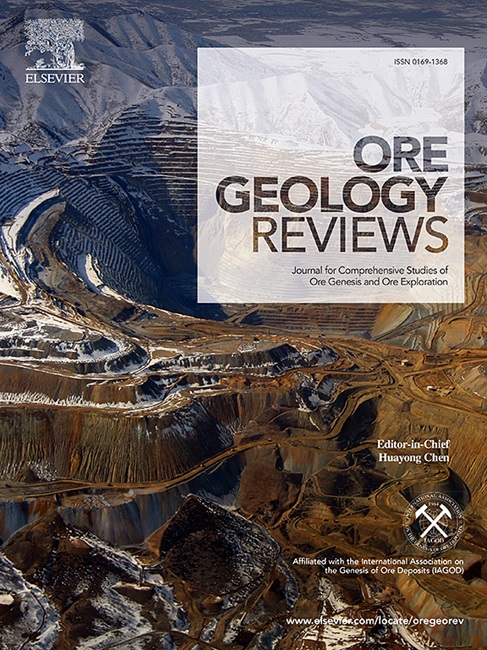Tourmaline compositions trace the sources of metals in the Tangziwa Sn-Cu deposit, Gejiu ore district, China
IF 3.2
2区 地球科学
Q1 GEOLOGY
引用次数: 0
Abstract
Major Sn-Cu deposits in the Gejiu ore district are genetically related to granitic intrusions. As Sn and Cu are lost during magma evolution in oxidized and reduced systems, respectively, they do not enrich together in the same magma. Therefore, the formation of Sn-Cu deposits in magmatic systems is debated. In particular, it is unclear whether Cu was added during late-stage magma evolution or after the crystallization of the magma. We address this question by analyzing tourmaline from the Tangziwa Sn-Cu deposit. The uniform B isotopic compositions of tourmaline (δ11B = −16.61 to −14.45 ‰) indicate that it crystallized from granitic melts or magmatic hydrothermal fluids. The chemical compositions of tourmaline track the evolution of fluids and melts from which tourmaline crystallized and record the availability of compatible elements. Tourmaline has high Sn contents, which shows that Sn was abundant in the melt. In contrast, the Cu contents in toumaline (less than 15 ppm) are low as for typical Sn-rich granites and much lower than in tourmaline from Cu-rich magmas that form Cu-Mo-Au porphyry deposits (Cu contents in such tourmaline may reach ∼1000 ppm). This implies that the granitic melts from Tangziwa had low Cu contents and these melts could not be the source of Cu in the deposit. Our data demonstrate that Cu was introduced after crystallization of tourmaline, possibly by the same fluid that resulted in extensive alteration of the granitic rocks and the mobilization of Sn from magmatic minerals to form alteration, skarn, vein, and sulfide type Sn deposits.

个旧矿区塘子洼锡铜矿的电气石成分溯源
个旧矿区主要的锡铜矿床与花岗岩侵入体有成因关系。由于Sn和Cu在岩浆演化过程中分别在氧化体系和还原体系中丢失,它们不能在同一岩浆中同时富集。因此,岩浆体系中锡铜矿床的形成存在争议。特别是Cu是在岩浆演化后期加入的,还是在岩浆结晶后加入的,目前还不清楚。本文通过对唐子洼锡铜矿床电气石的分析来解决这一问题。电气石B同位素组成均匀(δ11B = - 16.61 ~ - 14.45‰),表明其结晶于花岗岩熔体或岩浆热液。电气石的化学成分跟踪了电气石结晶的流体和熔体的演变,并记录了相容元素的可用性。电气石中Sn含量高,说明熔体中Sn含量丰富。相比之下,电气石中的Cu含量(小于15 ppm)低于典型的富锡花岗岩,远低于形成Cu- mo - au斑岩矿床的富Cu岩浆中的电气石(此类电气石中的Cu含量可达~ 1000 ppm)。这说明塘子洼花岗岩熔体铜含量较低,不可能是铜的来源。我们的数据表明,铜是在电气石结晶后引入的,可能是由同样的流体引入的,这种流体导致了花岗岩的广泛蚀变,并从岩浆矿物中动员了锡,形成了蚀变、矽卡岩、脉状和硫化物型锡矿床。
本文章由计算机程序翻译,如有差异,请以英文原文为准。
求助全文
约1分钟内获得全文
求助全文
来源期刊

Ore Geology Reviews
地学-地质学
CiteScore
6.50
自引率
27.30%
发文量
546
审稿时长
22.9 weeks
期刊介绍:
Ore Geology Reviews aims to familiarize all earth scientists with recent advances in a number of interconnected disciplines related to the study of, and search for, ore deposits. The reviews range from brief to longer contributions, but the journal preferentially publishes manuscripts that fill the niche between the commonly shorter journal articles and the comprehensive book coverages, and thus has a special appeal to many authors and readers.
 求助内容:
求助内容: 应助结果提醒方式:
应助结果提醒方式:


